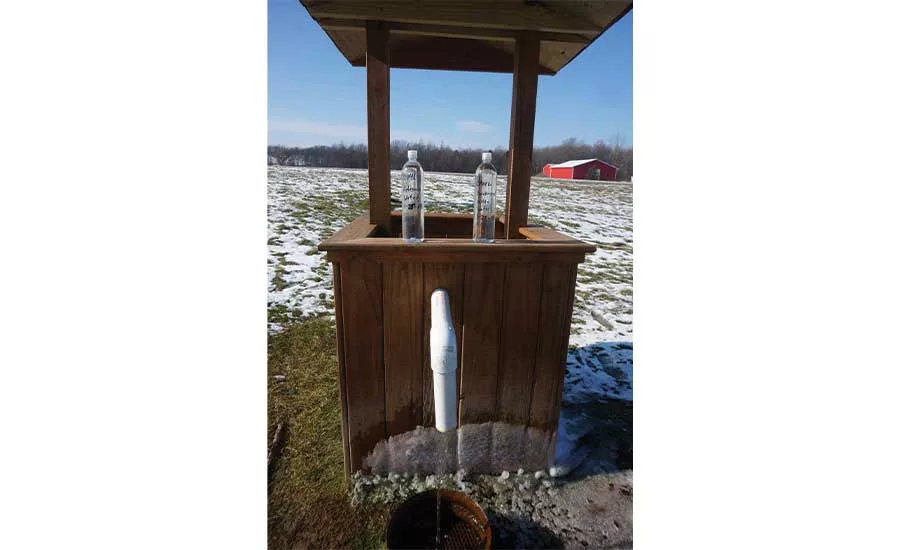Water Wells: The Original 'Raw Water'

A “raw” water source might include a spring-fed creek or river, but the kinds of microbes or particulates in it can be anyone’s guess.
Source: Brock Yordy

With the right marketing, well drillers can convince a new generation of health-conscious consumers that they have the original, unrefined and untouched water product, delivered instantaneously by Mother Nature.
Source: Brock Yordy
People are drinking raw water! “We have to save them,” is what humanitarian groups would say if people were drinking raw water in a Third World country. No, this is happening in America, and the raw food lifestyle trend started the movement.
Before we decide if this is a healthy solution or absolute insanity, we need to understand what the 21st century definition of raw water is and what is involved in drinking it. Raw water is an engineering term meaning “untreated feed water” or a municipality term that applies to “water in its natural state, before any treatment.”
My imagination ran wild when I thought about what was involved in drinking raw water. I imagined a group of people on a vision quest, deep in the wilderness, to find a unique rock outcrop formation that flowed a perfect stream of crystal clear water. This time, my overactive imagination was 100 percent correct. Raw water startups have employees in search of natural springs, gathering the water in glass jugs. One video showed a man filling a jug from a copper pipe coming out of the side of a hill. Another shows a man submerging a glass jug into surface water surrounded by leaves.
The next step is to chill the water and deliver it to the customer’s home in those same glass jugs. The raw water trend is based on the belief that Mother Nature does the best job filtering water, and that springs have the purest unrefined water with the best nutrients possible. One startup states that their business is delivery and water is free and their “delivery business” is good.
It All Adds Up
Clean water provides a healthy life. The World Health Organization’s recommended daily intake of water for men is 3.7 liters or 125 ounces, and for women 2.7 liters or 91 ounces. A family of four’s combined recommended consumption is 3.38 gallons per day and 23.6 gallons per week.
If you were to drink all of your daily water requirements in raw water, what would it cost? The average advertised cost is $16.00 per 2.5-gallon glass jug, plus jug deposit, taxes and delivery. A family of four could expect to spend $402.75 in the first week because of an upfront deposit, with a subsequent weekly cost of roughly $182.75. As I said, a family of four will consume 23.6 gallons of water a week, which the raw water company would provide in 2.5-gallon jugs. That adds up to 10 2.5-gallon jugs, for a total of 25 gallons weekly. A family of four could easily spend $10,000 a year in raw water.
Let’s drill deeper into the raw water business. The goal of the company is to provide water that is spring- or artesian-fed. They say that spring water is the purest and cleanest water in the world because it is filtered by Mother Nature. Depending on the source of the spring, that statement could be true. That statement is also true for a properly constructed aquifer water well. The raw water message is continued by pointing out that refined water is just as bad as processed food. The product is marketable because their customers have concerns about what is in their tap water. Beyond the state required chlorine and fluoride in many municipal water systems, there are many other unknown and undesirable components. These components are introduced from naturally occurring sources and human-made sources. Tap water consumers are concerned about microbiological contamination from sewage and gray water, as well as possible hazardous mineral contamination like naturally occurring arsenic and lead from our aging infrastructure.
The most significant concern comes from the amount of unknown pharmaceutical drugs in our public water supply. Studies are proving that the endocrine systems in people and animals are being affected by the low-trace pharmaceuticals in tap water. It is known that modern water processing is unable to completely remove birth control, blood pressure medicine, hair loss care, psychiatric drugs and many others. Alternatively, water well owners have concerns about nitrates, arsenic and contamination from old or poorly constructed wells.
Because of all this, the raw water business is growing every day. Many raw water providers are popping up across the country. The business model to move consumers away from drinking tap water is a small part of their plan. The more prominent market is anyone looking for a healthier lifestyle. Their advertising campaign of raw water providing microbes, probiotics, and minerals that can aid in better mental and physical health is appealing to both city homeowners and water well owners.
A Different Business Model
I expect starting a raw water delivery business would be very similar to starting a water well business. A raw water business requires a refrigerated building, which is priced similar to a top-head rotary drill. It requires vehicles for transportation from the spring to the building just like a water well rig requires a water truck. Next, the business needs supporting equipment like glass carboys for water transportation, retail bottles, tools for handling/cleaning and personnel. In a major metropolitan city, good help will be a minimum of $13 an hour and a CDL driver will be at least $18 an hour. It’s easy to see a raw water delivery service and water well business having the same monthly expenses, just spread out differently. Finally, a naturally occurring spring on public land generally isn’t in the middle of a metropolitan city. Any spring found in a major city would likely be contaminated by the surrounding industry. A delivery business can expect a long haul to obtain their product.
With the retail price of raw water, I figure a delivery business would have to deliver 3,000 gallons to break even and 6,000 gallons to sustain and grow. Therefore, both businesses are only as good as their understanding of investment, operational cost and profit. Understanding the needs of your customer and supplying that demand while sustaining and growing your business is key to success. Is it possible to sell people a delivery service for spring water? Yes, as this business has been around several years as a partner to the raw food trend. At the end of 2017 and early this year, news outlets started featuring stories about the Silicon Valley movement to drink raw water. Since then, the providers have been sold out, scrambling to keep up with the demand.
The raw food movement understands that there is risk to drinking spring water. They caution their consumers to drink raw water responsibly by keeping it chilled and drinking within “one moon cycle.” Health professionals across the country fear that people that consume raw water could contract E. coli, salmonella, cholera and other waterborne diseases. A secondary health risk is the bottling process and storage. Any driller who has had to take a water sample understands the importance of taking a sample without introducing rogue bacteria. As an industry, we know that a water well is a safe source of raw water; when properly installed, there is no fear of waterborne diseases.
The raw water community promotes the use of artesian water wells or well water when natural springs are unavailable. That’s because the raw water community understands that a properly installed well was drilled following all state and local regulations. They understand that the driller used National Ground Water Association (NGWA) best practices and that the well was built with all NSF Standard 60 and 61 certified products. It’s simple: A properly installed well guarantees safe drinking water. Yes, for both water wells and springs, the water quality and quantity will always depend on the source, its protection and the geologic formation. Despite the health risks, the difference between the raw water movement and water well industry is the raw water industry’s approach to 21st century marketing.
Opportunity for the Water Well Community
My father taught me that “word-of-mouth” was all the marketing required for a business to be successful. Man, that was a gamble with a business name like “Yordy and Sons.” We were the last entry in the Yellow Pages! Yet he built a great business on providing safe drinking water and knowing his customers would pass on his card. There was a lot of value in word-of-mouth marketing before the inventions of the Internet and the smartphone. Now it’s all about popping up first in an online search and providing the best customer education.
The raw water movement started in Silicon Valley, where marketing supersedes the product. The best product does not always win in the tech game. The product that works adequately and has the best marketing wins. It’s about understanding the customers’ needs and educating them on why your product is better. The marketing message of the raw water movement is to move away from municipal water and refined/processed bottled water for an untouched natural source of water. In 2015, I wrote an article called “How the Consumer Views the Value of a Water Well.” In that article, I provided a statistic that bottled water is valued, per ounce, about 700 times greater than well water. Bottled water gained market share because the consumer was educated to believe that bottled water is safer and more regulated. Bottled water is filtered, refined and processed until it is 99.9 percent without the natural elements found in its source. In the past few years, the bottled water industry has been scrutinized for misrepresenting water source and quality. Raw water capitalized on the pitfalls of the bottled water industry and their product is now valued, per ounce, about 250 times more than an ounce of bottled water. Raw water is gaining market share by quenching consumers’ thirst for knowledge. They understand the value of their product and how to promote it through educational videos and “digital word of mouth” — aka customer reviews and blogs.
The consumers of raw water could easily become water well owners. A drilling package could be designed to accommodate everything they seek in untreated natural water. Water wells built entirely free of undesirable impurities. You can educate the raw water consumer that a water well drilled through several confining layers and built correctly will provide a lifetime of natural fresh water. That family of four that spends $10,000 a year on raw water delivery can purchase a new water well once, and they are responsible for protecting the quality of their source. No other hands but their own will be involved in harvesting their water. The time is now to educate a whole new class of groundwater drinkers. A healthy group of raw water drinkers could join together and purchase a community well on property just outside a city if they knew that was a healthy option that fit their water needs. It comes back to how the groundwater industry approaches these customers. Our marketing message should be, “We provide safe drinking water — unrefined and untouched with desired minerals — and delivery is provided instantaneously by Mother Nature for free.”
Looking for a reprint of this article?
From high-res PDFs to custom plaques, order your copy today!





